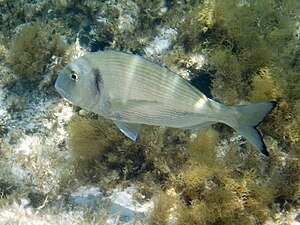Sea bream
| Sea bream | ||||||||||||
|---|---|---|---|---|---|---|---|---|---|---|---|---|

Sea bream ( Sparus aurata ) |
||||||||||||
| Systematics | ||||||||||||
|
||||||||||||
| Scientific name of the genus | ||||||||||||
| Sparus | ||||||||||||
| Linnaeus , 1758 | ||||||||||||
| Scientific name of the species | ||||||||||||
| Sparus aurata | ||||||||||||
| Linnaeus, 1758 |
The sea bream ( Sparus aurata ), also known under the names Dorade , Dorade Royale , or Orata , is a food fish that has been known since ancient times . It is the only species of the genus Sparus from the sea bream family (Sparidae).
description
The sea bream is strongly built. The body is high back and strongly flattened at the sides, the head rounded and relatively large. The dorsal fin is elongated and reinforced with spiny rays. The caudal fin is deeply forked, the pectoral fins long and pointed. The body of the sea bream is covered with silver scales. At the rear edge of the gill cover there is a black spot, between the eyes the gold band that gives it its name. The mouth of the sea bream is terminal to slightly below, the lips are thick, the teeth consist of strong molars.
The sea bream is usually between 25 and 35 centimeters long and up to 2.5 kilograms in weight, but specimens over 70 centimeters in length are rarely caught, the world record is 17.2 kilograms.
Way of life
The sea bream lives close to the coast at depths of 5 to 150 meters. It prefers sandy or gravelly soil, but can also be found on reefs and rocky coasts. The fish are usually diurnal and solitary, in heavily fished areas the activity can shift into the night.
Sea bream patrol individually along structures in the water, they usually swim near the sea floor. In contrast to many other sea bream, the fish are just as shy of divers and snorkelers as they are of boats.
A special feature of sea bream is that there are no purely male or female animals. They are always bisexual - male up to the age of two years and height of 20 to 30 centimeters, then female. This order seems logical, as less body size is sufficient for the production of small sperm than for eggs with egg yolk.
food
The main food is made up of mussels, snails and crabs such as Norway lobster, beach crabs or slipper crabs, whose hard shells and shells the sea bream can easily crack. In addition, squid and cuttlefish as well as smaller fish species such as pipefish, earfish, lyre fish, sardines, anchovies and seahorses are eaten.
distribution
The sea bream lives mainly in the Mediterranean Sea, its distribution area extends in the Atlantic to the North African coast, the Canary Islands and north to the British Isles.
Fishing, aquaculture and exploitation
The sea bream is an extremely tasty and high-priced food fish with fine, white meat that is used both raw and grilled, fried, baked or steamed. It is caught with gillnets, trawls and longlines .
While the sea bream has become rare in nature, it is grown on a large scale in aquaculture in net cages. The fish that come from there do not match the quality of wild fish, but they are still exquisite food fish. Sea bream are now successfully bred in Greece , Turkey , Israel , Italy , Spain and Croatia , among others , with Greece and Croatia being the largest producers.
The fishing rod is used to catch sea bream on and near the bottom with mussels, crabs and bait fish. The animals are very strong at fighting and are a sought-after and special catch in the Mediterranean.
Web links
- Sea bream on Fishbase.org (English)
Individual evidence
- ^ A b Louisy, Patrick: "Europe and the Mediterranean - European Fish Identification Giude". Ulmer, 2015.
- ↑ fao.org Information on aquaculture fao.org/fishery/culturedspecies/ (accessed on September 24, 2014).
- ^ Lexicon of Biology - Spectrum Lexicon of Biology - Spektrum Verlag (accessed on September 24, 2014).
- ↑ a b sea bream on Fishbase.org (English)


